Tsunami Boulders on the Rocky Coasts of Ibiza and Formentera (Balearic Islands)
Abstract
1. Introduction
1.1. Geological Framework
1.2. Wave Climate
1.3. Tsunamis in Ibiza and Formentera
2. Methods
- Geomorphological map of the coastal areas at a 1:1000 scale.
- The dimensions of the boulders were measured (a, b, c axis on behalf of the long, intermediate, and short axis, respectively). According to [10], the volume of a boulder that is based on a multiplication of the central axis (Vabc) overestimates the actual volume and produces an overestimation of the wave energy and wave heights needed for their transport. Those authors, through a complex process of digital photography, [10] estimate the real volume as 49% of the Vabc. To estimate that percentage for our measured volumes, we did a test on several boulders through decomposing the volume of the block in measurable parallelepipeds that by addition represent more accurately the real volume of the block. On average, the volume by triangulation was 68% of the Vabc. This percentage has been applied to all of the analyzed blocks.
- The height above mean sea level of the boulders, and their distance from the edge of the cliff were also measured as well. Their orientation and imbrication were considered, and the geomorphological context in which they were found. Isolated boulders, an imbricated group of boulders or ridges of imbricate boulders, were also registered.
- (a)
- The relation of the boulders with its source area (based on bed thickness, facies, and lithology), and the presence of fractures that can promote detachment of the boulders,
- (b)
- The presence of encrusted marine fauna indicating the origin of the boulder before its displacement,
- (c)
- The presence of pre-detachment and post-detachment solution pans which have been used as age indicators for boulder emplacement,
- (d)
- The degree of rounding of the boulders, presence or absence of another type of sediment as well as the presence of abrasion surfaces due to boulder quarrying and transport,
- (e)
- The presence of flow-outs, areas with denudated beds forming channels over the cliff, favoring the entry and acceleration of the water flows and leaving a boulder ridge at its front.
3. Results
3.1. Ibiza: Punta Pedrera
3.2. Ibiza: Sant Antoni
3.3. Ibiza: Ses Eres Roges
3.4. Ibiza: Pou des Lleó
3.5. Ibiza: Punta Arabí
3.6. Formentera: Punta Prima
3.7. Formentera: Punta de sa Gavina
3.8. Application of Hydrodynamic Equations
3.9. Dating of the Boulders
3.10. Discussion
4. Conclusions
Supplementary Materials
Author Contributions
Funding
Acknowledgments
Conflicts of Interest
References
- Ciavola, P.; Ferreira, O.; Haerens, P.; van Koningsveld, M.; Armaroli, C.; Lequeux, Q. Storm impacts along European coastlines. Part 1: The joint effort of the MICORE and ConHaz Projects. Environ. Sci. Policy 2011, 14, 912–923. [Google Scholar] [CrossRef]
- Scheffers, A.; Scheffers, S. Documentation of Hurricane Ivan on the Coastline of Bonaire. J. Coast. Res. 2006, 22, 1437–1450. [Google Scholar] [CrossRef]
- Goto, K.; Okada, K.; Imamura, F. Characteristics and hydrodynamics of boulders transported by storm waves at Kudaka Island, Japan. Mar. Geol. 2009, 262, 14–24. [Google Scholar] [CrossRef]
- Biolchi, S.; Furlani, S.; Antonioli, F.; Baldassini, N.; Causon Deguara, J.; Devoto, S.; di Stefano, A.; Evans, J.; Gambin, T.; Gauci, R.; et al. Boulder accumulations related to extreme wave events on the eastern coast of Malta. Nat. Hazards Earth Syst. Sci. 2015, 3, 5977–6019. [Google Scholar] [CrossRef]
- Morton, R.A.; Richmond, B.M.; Jaffe, B.E.; Gelfenbaum, G. Coarse-clast ridge complexes of the Caribbean: a preliminary basis for distinguishing tsunami and storm-wave origins. J. Sedim. Res. 2008, 78, 624–637. [Google Scholar] [CrossRef]
- Imamura, F.; Goto, K.; Ohkubo, S. A numerical model for the transport of a boulder by tsunami. J. Geophys. Res. 2008, 113, C01008. [Google Scholar] [CrossRef]
- Scheffers, A.M.; Kinis, S. Stable imbrication and delicate/unstable settings in coastal boulder deposits: Indicators for tsunami dislocation? Quat. Int. 2014, 332, 73–84. [Google Scholar] [CrossRef]
- Etienne, S.; Paris, R. Boulder accumulations related to storms on the south coast of the Reykjanes Peninsula (Iceland). Geomorphology 2010, 114, 55–70. [Google Scholar] [CrossRef]
- Nott, J. Tsunami or storm waves? Determining the origin of a spectacular field of wave emplaced boulders using numerical storm surge and wave models and hydrodynamic transport equations. J. Coast. Res. 2003, 19, 348–356. [Google Scholar]
- Engel, M.; May, S.M. Bonaire’s boulder fields revisited: Evidence for Holocene tsunami impact on the Lee-ward Antilles. Quat. Sci. Rev. 2012, 54, 126–141. [Google Scholar] [CrossRef]
- Scheffers, A.; Kelletat, D. Sedimentologic and geomorphic tsunami imprints worldwide—A review. Earth-Sci. Rev. 2003, 63, 83–92. [Google Scholar] [CrossRef]
- Furlani, S.; Pappalardo, M.; Gómez-Pujol, L.; Chelli, A. The rock coast of the Mediterranean and Black seas. Geol. Soc. Lond. Mem. 2014, 40, 89–123. [Google Scholar] [CrossRef]
- Roig-Munar, F.X. Blocs de Tempesta i Tsunami a les Costes Rocoses de les Illes Balears. Anàlisi Geomorfològica i Morfomètrica. Ph.D. Thesis, Departament de Geodinàmica i Geofísica, Universitat de Barcelona, Barcelona, Spain, 2016. [Google Scholar]
- Roig-Munar, F.X.; Vilaplana, J.M.; Rodríguez-Perea, A.; Martín-Prieto, J.A.; Gelabert, B. Presencia de bloques de tsunami en los acantilados de Punta Gavina (Formentera, Illes Balears). Geo-Temas 2017, 17, 223–226. [Google Scholar]
- Bartel, P.; Kelletal, D. Erster Nachweis Holozäner Tsunamis im Westlichen Mittelmeergebiet (Mallorca, Spanien) mit einem Vergleich von Tsunamiund Sturmwellenwirkung auf Festgesteinsküsten; Berichte Forschungs-und Technologiezentrum Westküste der Universität Kiel: Büsum, Germany, 2003; Volume 28, pp. 93–107. [Google Scholar]
- Kelletat, D.; Whelan, F.; Bartel, P.; Scheffers, A. New Tsunami evidences in Southern Spain Cabo de Trafalgar and Mallorca Island. In Geomorfologia Litoral i Quarternari, Homenatge al Professor Vincenç M. Rosselló i Verger; Sanjaume, E., Matheu, J.F., Eds.; Universitat de València: Valencia, Spain, 2005; pp. 215–222. [Google Scholar]
- Roig-Munar, F.X.; Vilaplana, J.M.; Rodríguez-Perea, A.; Martín-Prieto, J.A.; Gelabert, B. Tsunamis boulders on the rocky shores of Minorca (Balearic Islands). Nat. Hazards Earth Syst. Sci. 2018, 18, 1985–1998. [Google Scholar] [CrossRef]
- Roig-Munar, F.X.; Rodríguez-Perea, A.; Vilaplana, J.M.; Martín-Prieto, J.A.; Gelabert, B. Tsunami boulders in Majorca Island (Balearic Islands, Spain). Geomorphology 2019, 334, 76–90. [Google Scholar] [CrossRef]
- Álvarez-Gómez, J.A.; Aniel-Quiroga, I.; González, M.; Otero, L. Tsunami hazard at the Western Mediterranean Spanish coast from seismic sources. Nat. Hazards Earth Syst. Sci. 2011, 11, 227–240. [Google Scholar] [CrossRef]
- Rangheard, Y. The geological history of Eivissa and Formentera. In Biogeography and Ecology of the Pityusic Islands; Monographiae Biologicae 52; Kuhbier, H., Alcover, J.A., Guerau d’Arellano Tur, C., Eds.; Springer: Dordrecht, Germany, 1984; pp. 25–104. [Google Scholar]
- García de Domingo, A.; Díaz de Neira, J.A.; Gil-Gil, J.; Cabra-Gil, P. Cartografía y Memoria del Mapa Geológico de España a escala 1:25.000 (Plan MAGNA, 2ª serie) de la Hoja 799 I (Santa Eulària des Riu); Servicio de Publicaciones del IGME: Madrid, Spain, 2009. [Google Scholar]
- Del Valle, L.; Gómez-Pujol, L.; Fornós, J.J.; Timar-Gabor, A.; Anechitei-Deacu, V.; Pomar, F. Middle to Late Pleistocene dunefields in rocky coast settings at Cala Xuclar (Eivissa, Western Mediterranean): Recognition, architecture and luminescence chronology. Quat. Int. 2016, 407, 4–13. [Google Scholar] [CrossRef]
- Durand-Delga, M.; Rangheard, Y. Structure de l’île d’Eivissa (Ibiza) et sa place dans le cadre baléare. Boll. Soc. Hist. Nat. Balears 2013, 56, 25–50. [Google Scholar]
- Nozal, F.; Montes, M.; Díaz de Neira, J.A.; Sevillano, A.; Rodríguez-Garcia, A. Cartografía geomorfológica en el Dominio Público Marítimo-Terrestre. Geo-Temas 2015, 15, 121–124. [Google Scholar]
- Roig-Munar, F.X.; Ródriguez-Perea, A.; Martín-Prieto, J.A.; Vilaplana, J.M.; Gelabert, B. El uso de bloques de tormenta y de tsunami como materia prima en las islas Baleares. Rev. Soc. Geol. España 2016, 29, 79–88. [Google Scholar]
- Lionello, P.; Sanna, A. Mediterranean wave climate variability and its links with NAO and Indian Monsoon. Clim. Dyn. 2005, 25, 611–623. [Google Scholar] [CrossRef]
- Sotillo, M.; Ratsimandresy, A.; Carretero, J.; Bentamy, A.; Valero, F.; González-Rouco, F. A high-resolution 44-year atmospheric hindcast for the Mediterranean Basin: Contribution to the regional improvement of global reanalysis. Clim. Dyn. 2005, 25, 219–236. [Google Scholar] [CrossRef]
- Bertotti, L.; Cavaleri, L. Analysis of the Voyager storm. Ocean Eng. 2008, 35, 1–5. [Google Scholar] [CrossRef]
- Puertos del Estado. Available online: http://www.puertos.es/ca-es/oceanografia/Pagines/portus.aspx (accessed on 10 May 2019).
- Cañellas, B. Long-Term Extreme Wave Height Events in the Balearic Sea: Characterization, Variability and Prediction. Ph.D. Thesis, Universitat de les Illes Balears, Mallorca, Spain, 4 May 2010. [Google Scholar]
- Papadopoulos, G.A. The development of the National Tsunami Warning System of Greece. EMSC Newsl. 2009, 23, 20–21. [Google Scholar]
- Alasset, J.P.; Hebert, H.; Maouche, S.; Calbini, V.; Meghraoui, M. The tsunami induced by the 2003 Zemmouri earthquake (Mw p 6.9 Algeria): Modelling and results. Geophys. J. Int. 2006, 166, 213–226. [Google Scholar] [CrossRef]
- Roger, J.; Hébert, H. The 1856 Djiielli (Algeria) earthquake and tsunami source parameters and implications for tsunami hazard in the Balearic Islands. Nat. Hazards Earth Syst. Sci. 2008, 8, 721–731. [Google Scholar] [CrossRef]
- Sahal, A.; Roger, J.; Allgeyer, S. The tsunami triggered by the 21 May 2003 Boumerdès-Zemmouri (Algeria) earthquake: Field investigations on the French Mediterranean coast and tsunami modeling. Nat. Hazards Earth Syst. Sci. 2009, 9, 1823–1834. [Google Scholar] [CrossRef]
- Fontseré, E. Notas Sueltas de Sismología Balear; Publicaciones de la Sección de Ciencias Naturales, Facultad de Ciencias de la Universidad de Barcelona: Barcelona, Spain, 1918; pp. 5–12. [Google Scholar]
- Roig-Munar, F.X.; Vilaplana, J.M.; Rodríguez-Perea, A.; Martín-Prieto, J.A.; Gelabert, B. Indicadores geomorfológicos de tsunamis históricos en las costas rocosas de Baleares. Geo-Temas 2016, 16, 641–644. [Google Scholar]
- Martínez-Solares, J.M.; Mezcua-Rodríguez, J. Catálogo Sísmico de la Península Ibérica (880 a. C.-1990); Dirección General del Instituto Geográfico Nacional: Madrid, Spain, 2002; 253p, Silva and Rodriguez (2014). [Google Scholar]
- IDEIB, Infraestructura de Dades Espacials de les Illes Balears. Available online: https://ideib.caib.es/visor/ (accessed on 5 April 2019).
- Life Posidonia Project E: 1.5000. Available online: http://cedai.imedea.uib-csic.es (accessed on 22 January 2019).
- Pignatelli, C.; Sanso, P.; Mastronuzzi, G. Evaluation of tsunami flooding using geomorphologic evidence. Mar. Geol. 2009, 260, 6–18. [Google Scholar] [CrossRef]
- Nandasena, N.A.K.; Paris, R.; Tanaka, N. Reassessment of hydrodynamic equations: Minimum flow velocity to initiate boulder transport by high energy events (storms, tsunamis). Mar. Geol. 2011, 281, 70–84. [Google Scholar] [CrossRef]
- Bryant, E. Tsunami. The Underrated Hazard, 3rd ed.; Springer: Berlin, Germany, 2014; 222p. [Google Scholar]
- Lekkas, E.; Andreadakis, E.; Kostaki, I.; Kapourani, E. Critical Factors for Run-up and Impact of the Tohoku Earthquake Tsunami. Int. J. Geosci. 2011, 2, 310–317. [Google Scholar] [CrossRef][Green Version]
- Zhao, X.; Chen, Y.; Huang, Z.; Gao, Y. A numerical study of tsunami wave run-up and impact on coastal cliffs using a CIP-based model. Nat. Hazards Earth Syst. Sci. 2017, 1–17. [Google Scholar] [CrossRef]
- Emery, K.O. Marine solution basins. J. Geol. 1946, 54, 209–228. [Google Scholar] [CrossRef]
- Gómez-Pujol, L. Patrons, Taxes i Formes d’Erosió a les Costes Rocoses Carbonatades de Mallorca. Ph.D. Thesis, Departament de Ciències de la Terra, Universitat de les Illes Balears, Mallorca, Spain, April 2006. [Google Scholar]
- Roig-Munar, F.X.; Martín-Prieto, J.A.; Vilaplana, J.M.; Rodríguez-Perea, A.; Gelabert, B. Presencia de bloques de tsunamis en acantilados de Punta Prima (Formentera). In Comprendiendo el Relieve: Del Pasado al Futuro; Durán, J.J., Montes Santiago, M., Robador, A., Salazar, Á., Eds.; Instituto Geológico y Minero de España: Madrid, Spain, 2016; pp. 571–578. [Google Scholar]
- Switzer, A.D.; Burston, J.M. Competing mechanisms for boulder deposition on the southeast Australian coast. Geomorphology 2010, 114, 42–54. [Google Scholar] [CrossRef]
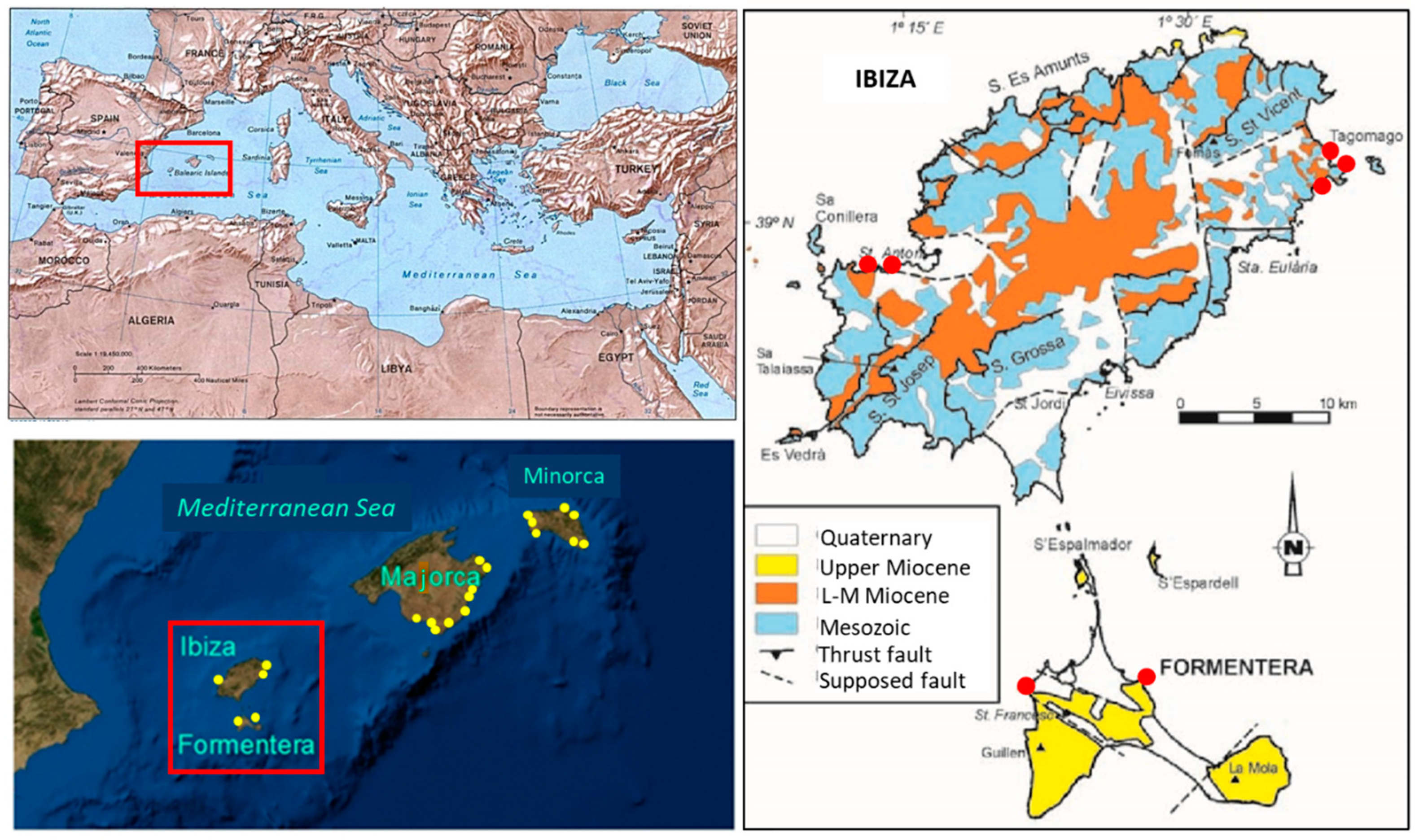
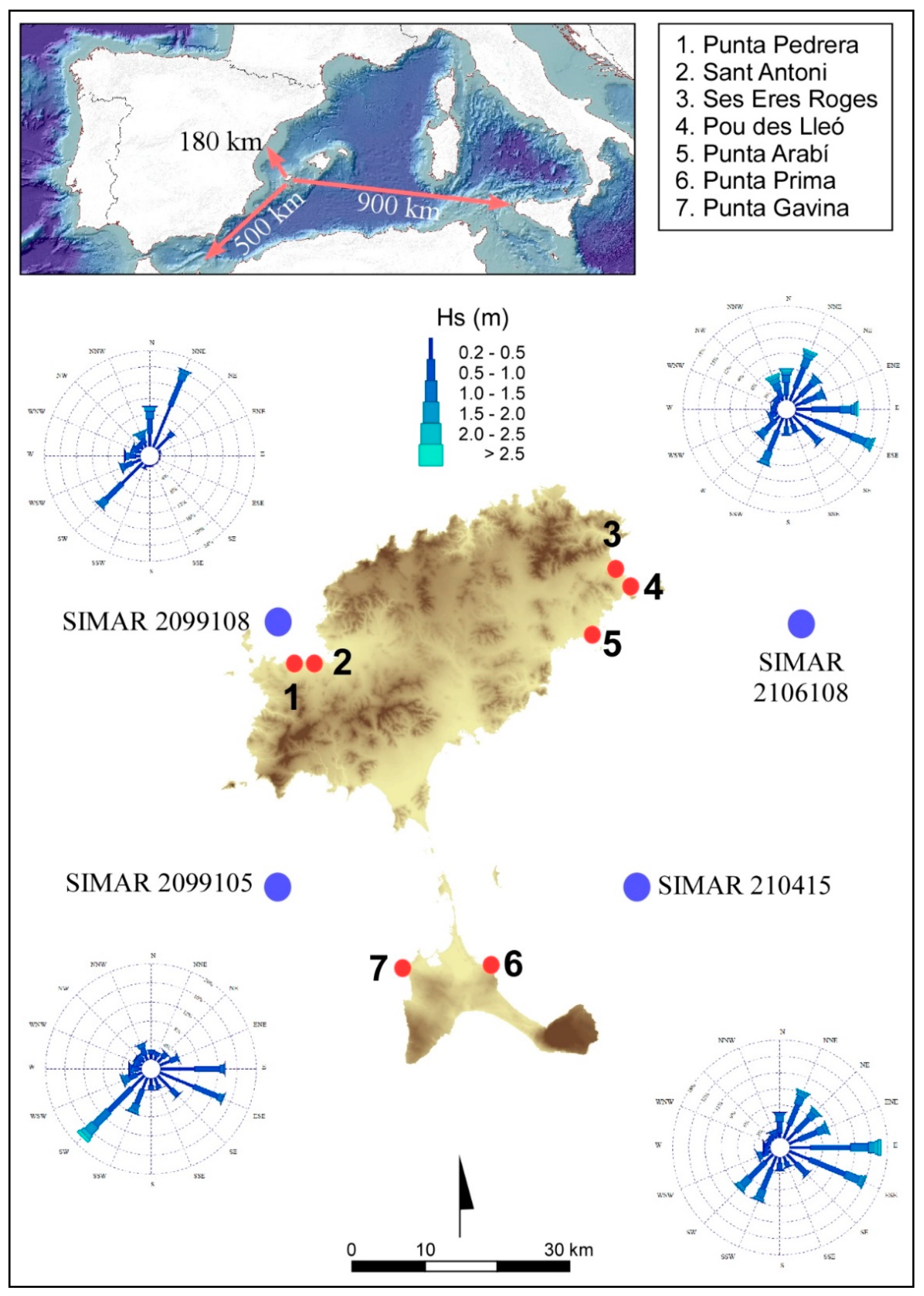

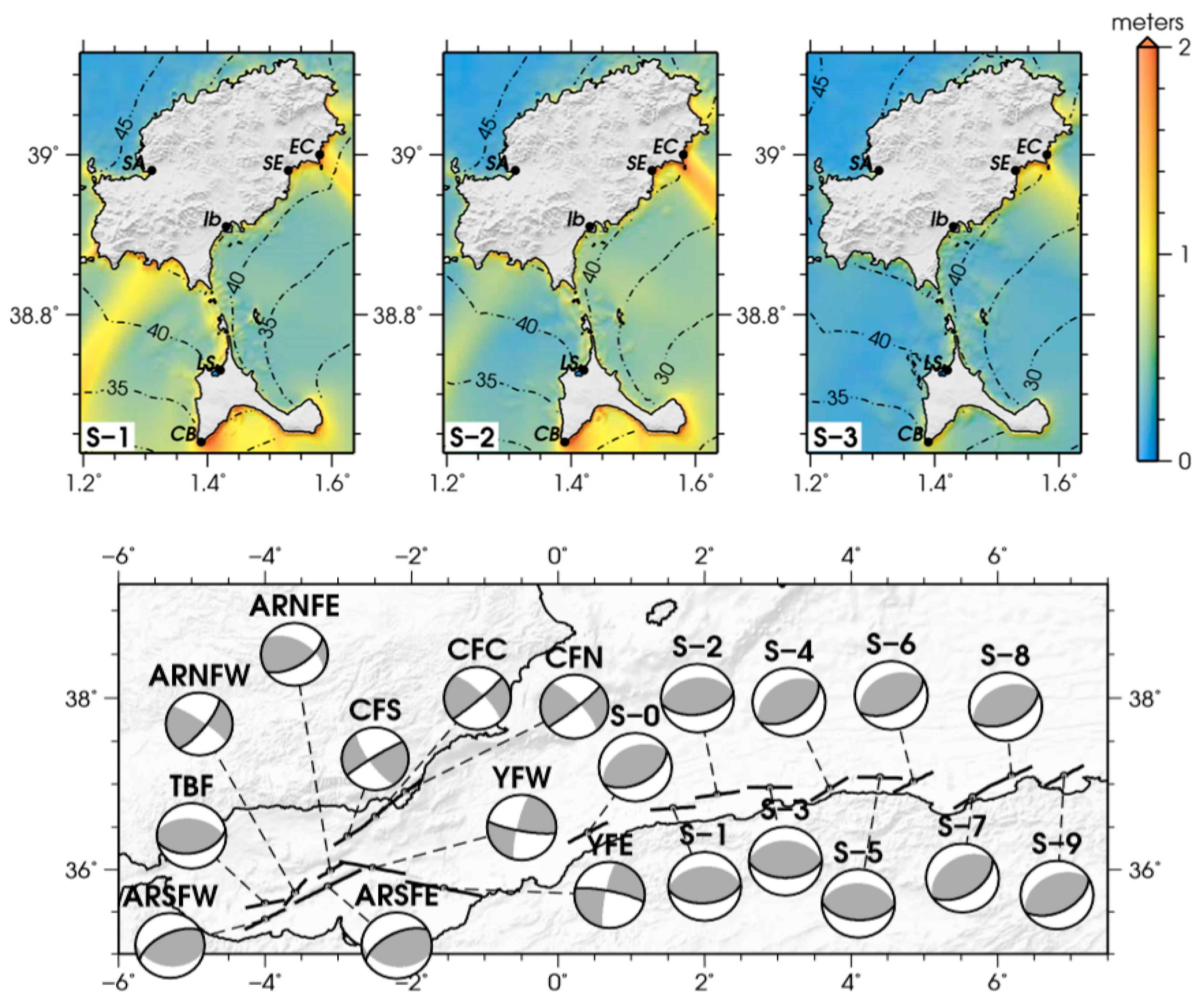
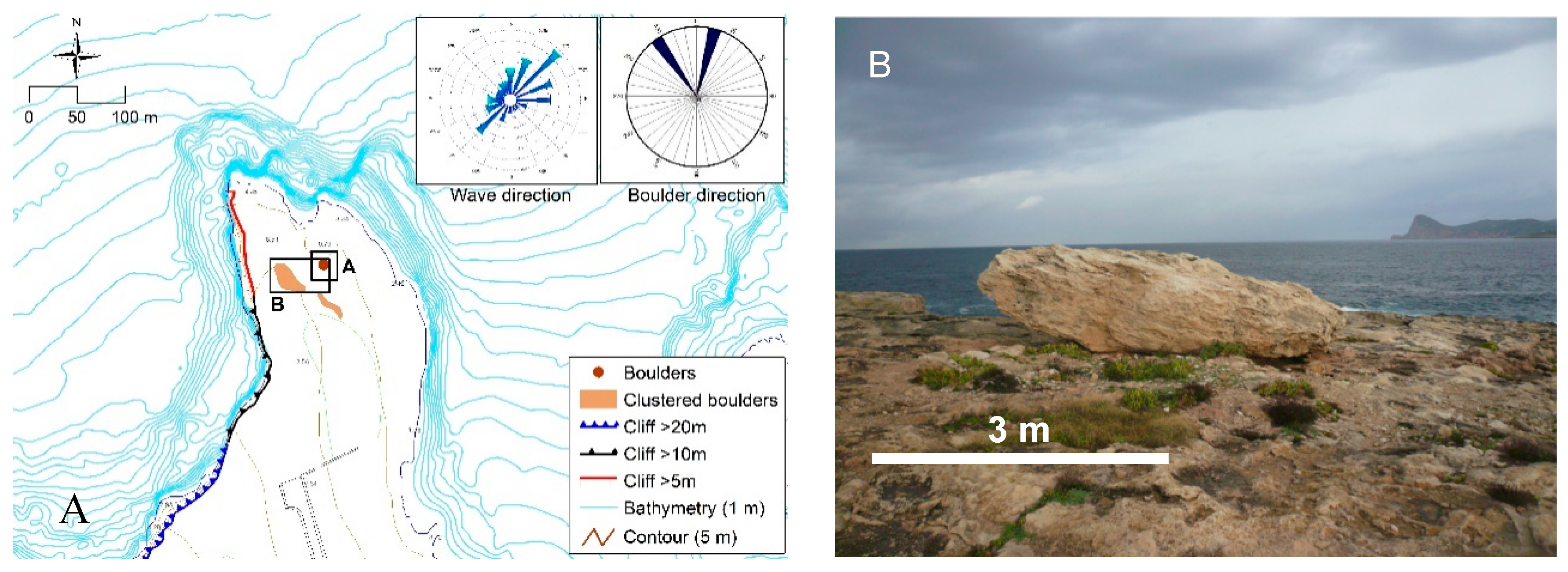

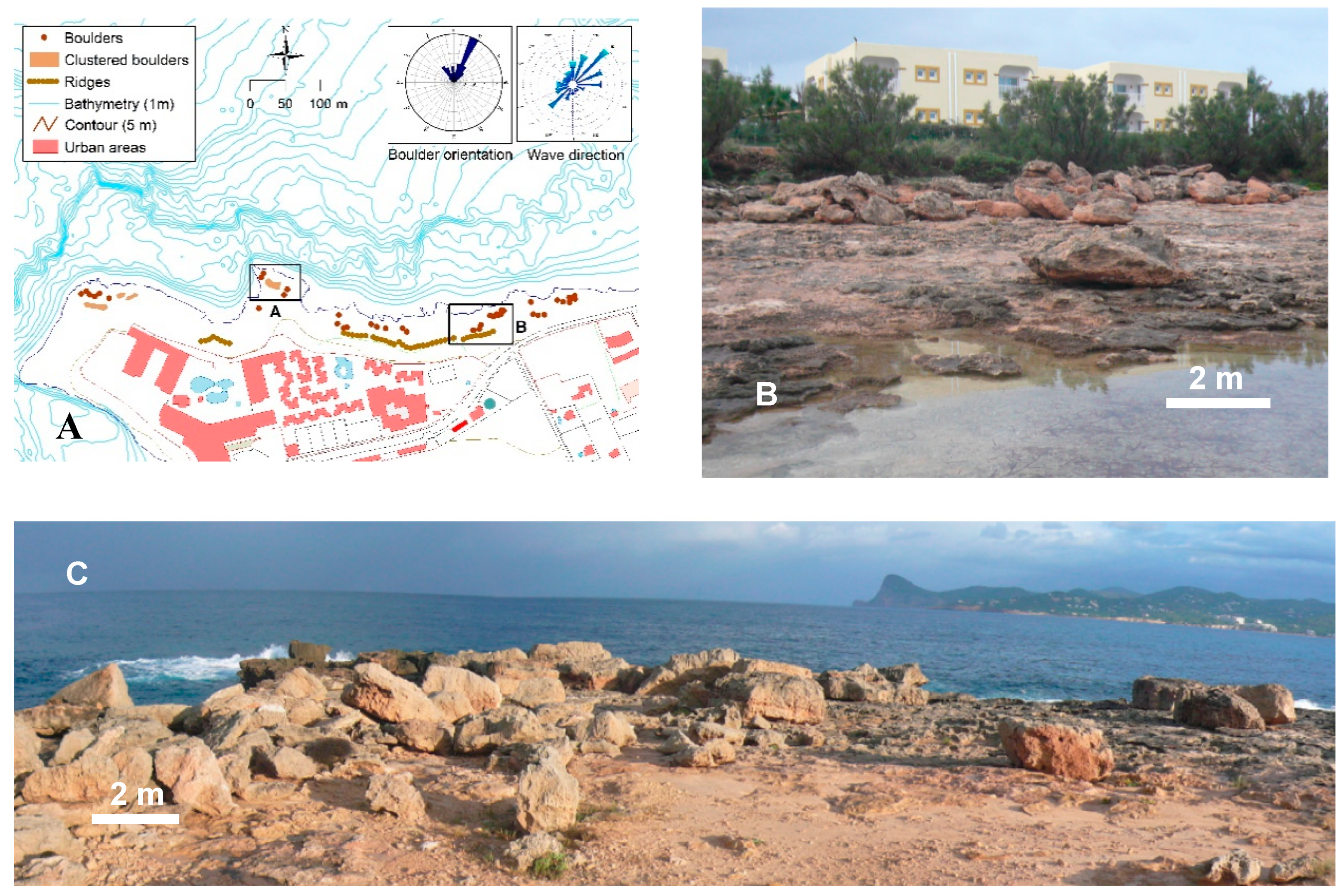
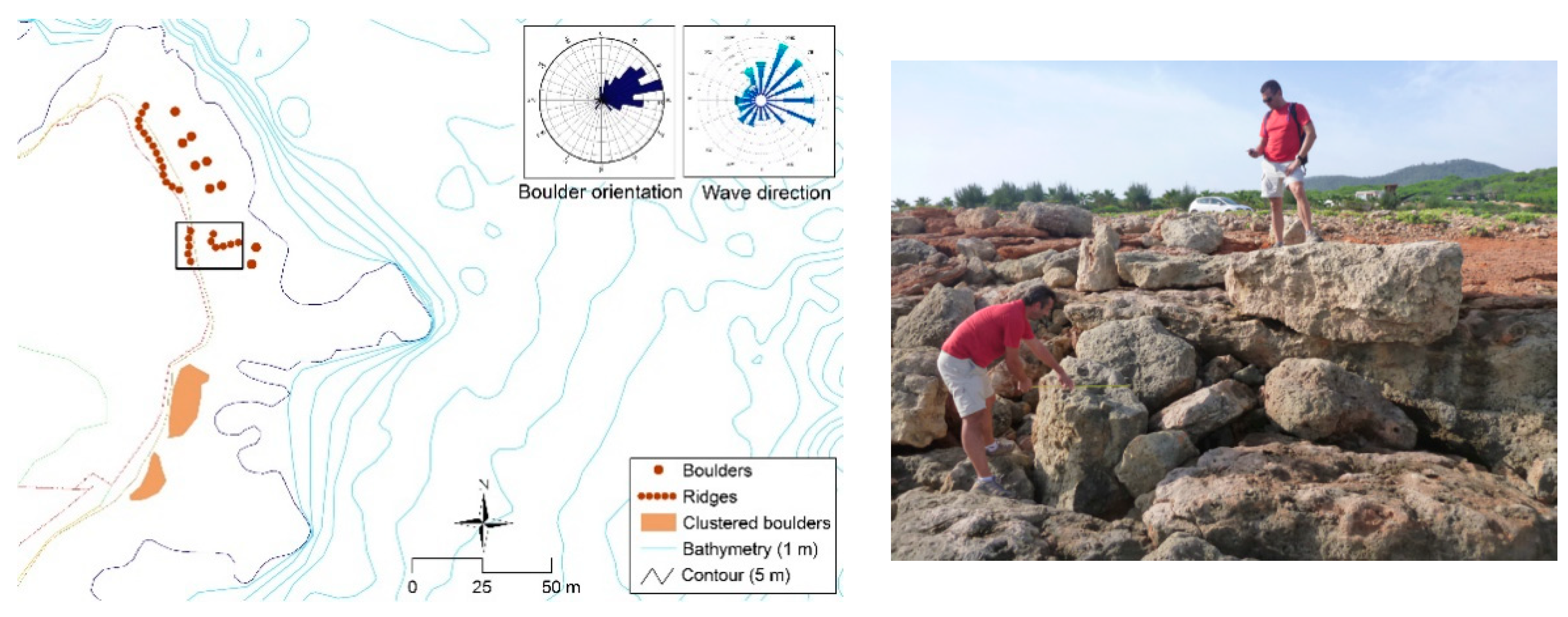
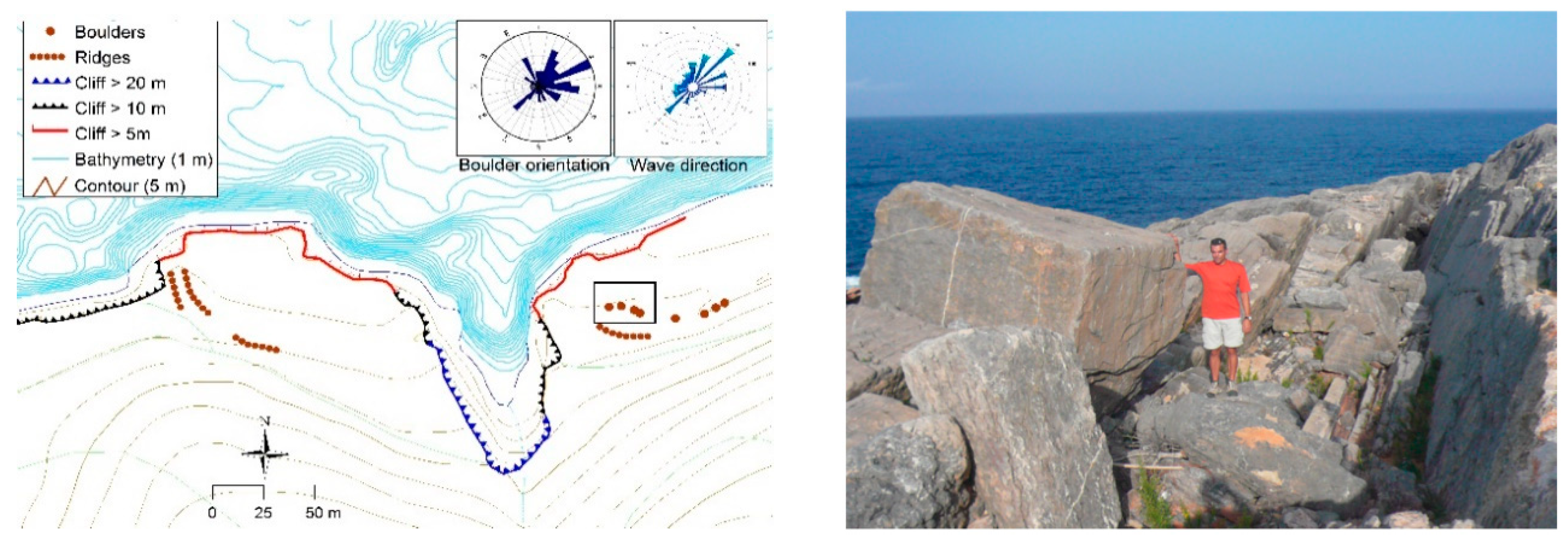
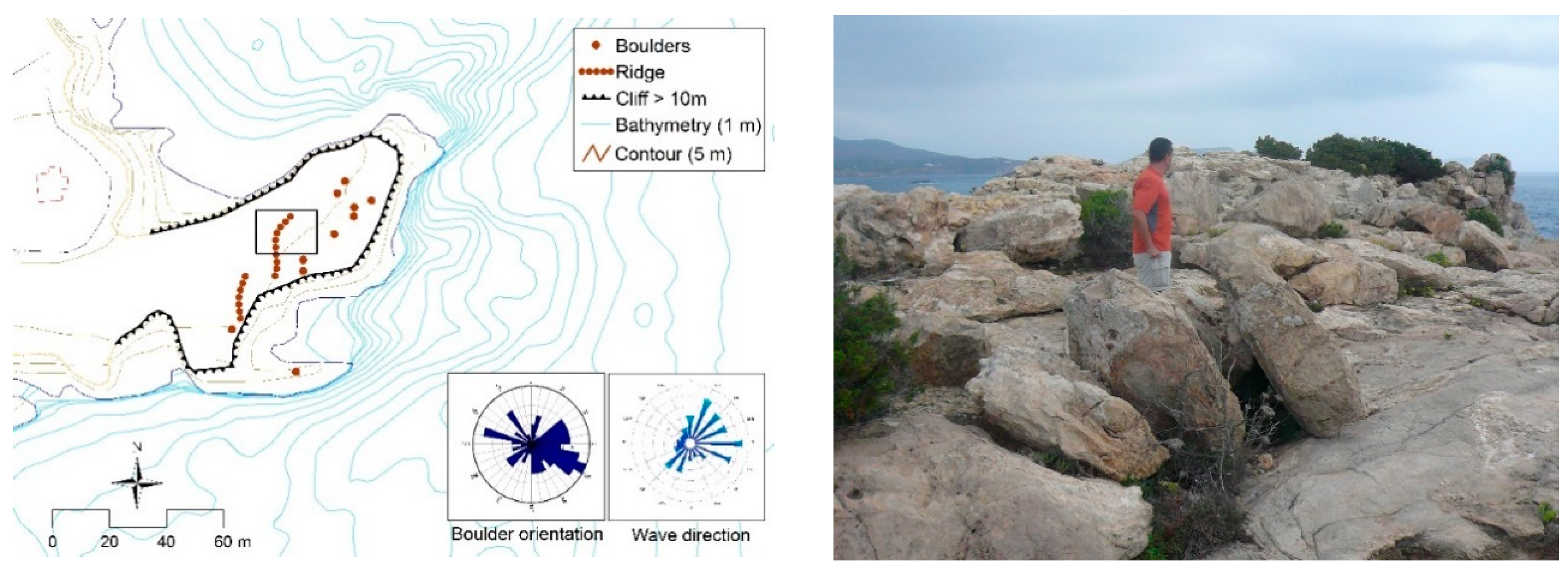
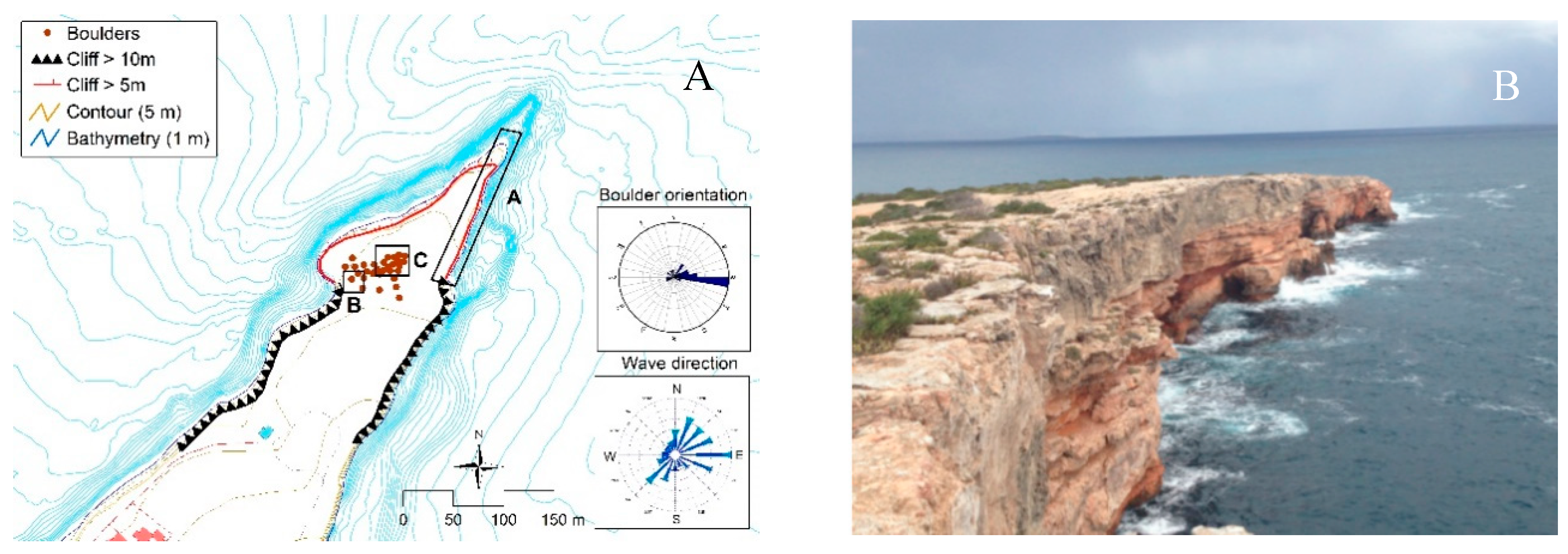

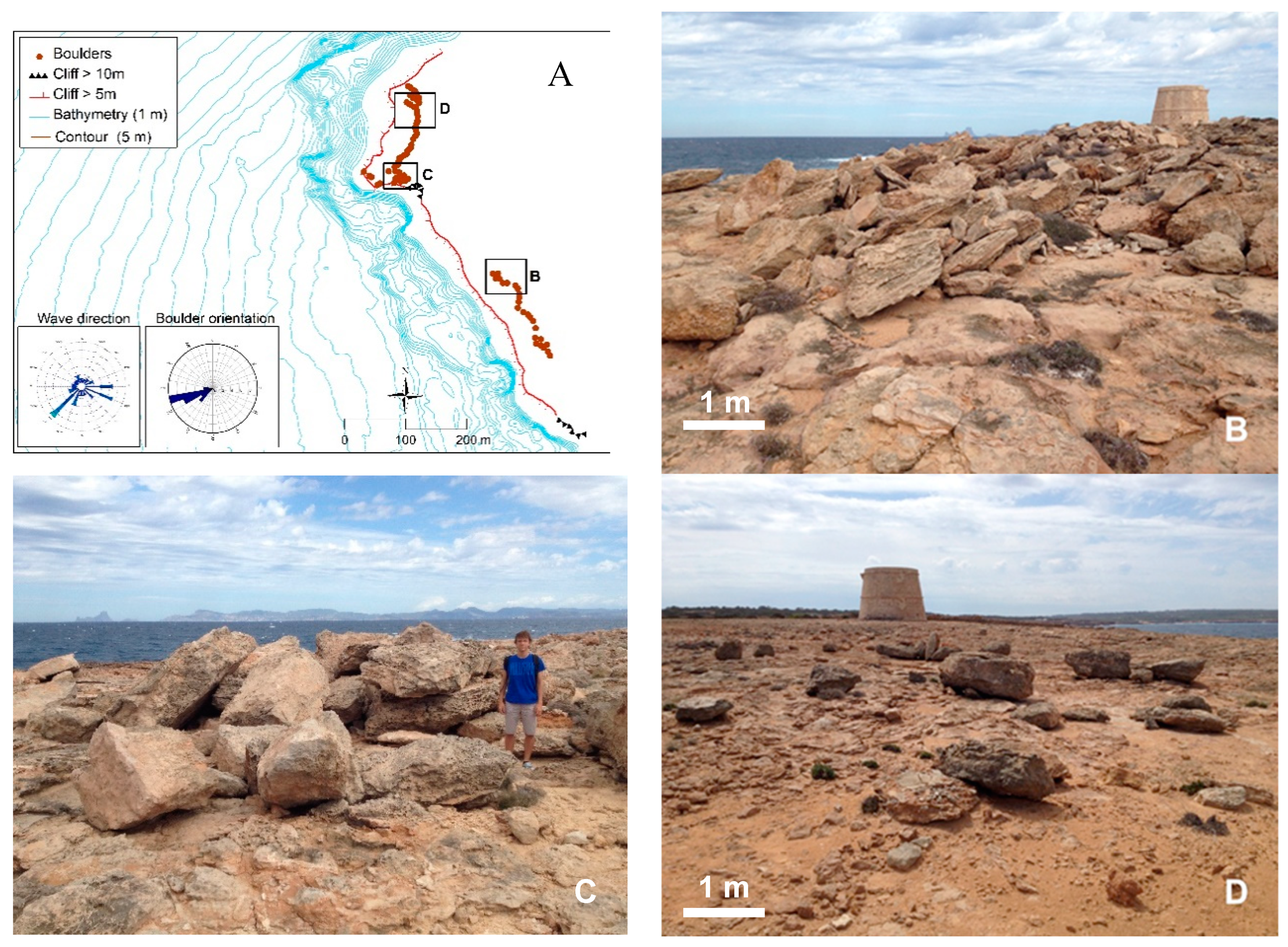
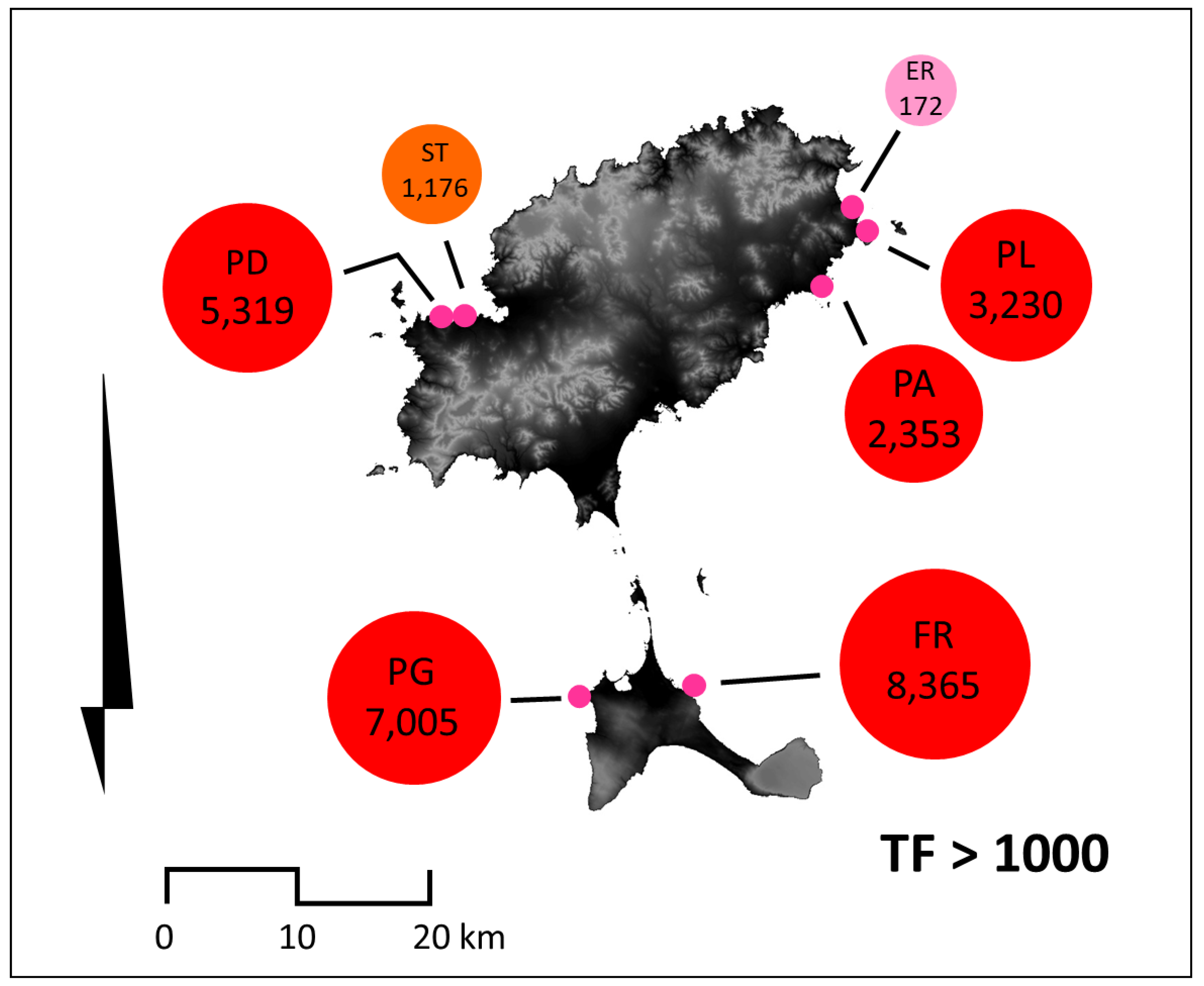
| SIMAR | Location | Water Depth | Fetch | Fetch Direction | Tp | Hs | Hs50 |
|---|---|---|---|---|---|---|---|
| 2099108 | 1.25 E–39.00 N | 95 m | 180 | NW | 10.99 | 5.17 | 11 |
| 2106108 | 1.83 E–39.00 N | 150 m | 920 | E | 10.46 | 5.83 | 11 |
| 2099105 | 1.25 E–37.75 N | 108 m | 500 | SW | 11.33 | 6.04 | 7 |
| 2104105 | 1.67 E–38.75 N | 325 m | 900 | E | 10.71 | 5.83 | 11 |
| Data | Affected Area | Phenomenon | IS |
|---|---|---|---|
| 1660 | Majorca, Palma, Campos | Earthquake and tsunami | 1 |
| 1721 | Balearic Islands | Earthquake and seawater withdrawal | 1 |
| 1756 | Majorca, Santanyí | Tsunami and big waves | 1 |
| 1756 | Balearic Islands | Tsunami and flooded coasts | 2 |
| 1790 | Alboran Sea | Tsunami | 2 |
| 1804 | Alboran Sea | Tsunami | 2 |
| 1856 | Minorca, Maó | Tsunami and seismic wave | 1 |
| 1856 | Algeria | Tsunami | 2 |
| 1885 | Algeria | Sea level changes | 2 |
| 1891 | Algeria | Tsunami | 2 |
| 1918 | Minorca, Maó | Seismic wave | 1 |
| 2003 | Algeria | Earthquake (7.0) and tsunami | 2 |
| Ht | Hs | |||||
|---|---|---|---|---|---|---|
| Nott (2003) [9] | submerged | Ht = [0,25(ρs − ρw/ρw) 2a]/[(Cd (ac/b2)+ Cl] | Hs = [(ρs − ρw/ρw) 2a]/[(Cd (ac/b2)+ Cl] | |||
| subaerial | Ht = [0,25 (ρs − ρw/ρw) [2a − Cm (a/b) (ü/g)]/[Cd (ac/b2)+ Cl] | Hs = [(ρs − ρw/ρw) [2a − 4Cm (a/b) (ü/g)] ]/[Cd (ac/b2)+ Cl] | ||||
| joint-bounded boulder | Ht = [0,25 (ρs − ρw/ρw) a]/Cl | Hs = [(ρs − ρw/ρw) a]/Cl | ||||
| Engel and May (2012) [10] | subaerial | Ht = 0,5·μ·V·ρb/CD·(a·c·q) ·ρw | Hs = 2·μ·V·ρb/CD·(a·c·q) ·ρw | |||
| joint-bounded boulder | Ht = (ρb − ρw)·V·(cosθ + μ· sin θ)/2·ρw.CL·a·b·q | Hs =(ρb − ρw)·V·(cos θ + μ· sin θ)/0.5· ρw.CL·a·b·q | ||||
| Ht | tsunami height | a | the large axis of the boulder | Cd | coefficient of drag | |
| Hs | storm wave height | b | the medium axis of the boulder | Cl | coefficient of lift | |
| ρs | boulder density | c | the short axis of the boulder | Cm | coefficient of mass | |
| ρw | seawater density | g | force of gravity | ü | the speed of water flow | |
| V | vol. abc of the boulder | q | boulder area coefficient | θ | clifftop steepness | |
| μ | coefficient of friction | |||||
| Study Area | Alt. | Dist. | Weight | Hc | Hs50 | JBB Run-up | Subaerial Run-up | Transport Figure | ||||
|---|---|---|---|---|---|---|---|---|---|---|---|---|
| Hs | Ht | Rs | Rt | Rs | Rt | |||||||
| Punta Pedrera | 10.0 | 66.0 | 8.4 | 9 | 11 | 10.5 | 3.4 | 19.5 | 12.4 | 11.9 | 10.4 | 5319 |
| Sant Antoni | 2.1 | 30.5 | 17.6 | 0.5 | 11 | 7.8 | 1.6 | 8.3 | 2.1 | 10.4 | 3.2 | 1126 |
| Ses Eres Roges | 3.5 | 25.0 | 14.5 | 1 | 11 | 6.5 | 0.9 | 7.5 | 1.9 | 4.9 | 2.8 | 172 |
| Pou des Lleó | 9.4 | 38.6 | 8.5 | 5.5 | 11 | 15 | 6.5 | 20.5 | 12.0 | 11.6 | 9.9 | 3230 |
| Punta Arabí | 14.5 | 35.0 | 4.6 | 10 | 11 | 11.4 | 6.2 | 21.4 | 16.2 | 17.6 | 15.1 | 2353 |
| Punta Prima | 11.7 | 83.0 | 8.7 | 9.5 | 7 | 12.2 | 4.7 | 21.7 | 14.2 | 13.5 | 12.1 | 8365 |
| Punta de sa Gavina | 11.3 | 59.0 | 10.7 | 9.5 | 11 | 12.6 | 4.5 | 22.1 | 14.0 | 13.1 | 11.7 | 7005 |
© 2019 by the authors. Licensee MDPI, Basel, Switzerland. This article is an open access article distributed under the terms and conditions of the Creative Commons Attribution (CC BY) license (http://creativecommons.org/licenses/by/4.0/).
Share and Cite
Roig-Munar, F.X.; Rodríguez-Perea, A.; Martín-Prieto, J.A.; Gelabert, B.; Vilaplana, J.M. Tsunami Boulders on the Rocky Coasts of Ibiza and Formentera (Balearic Islands). J. Mar. Sci. Eng. 2019, 7, 327. https://doi.org/10.3390/jmse7100327
Roig-Munar FX, Rodríguez-Perea A, Martín-Prieto JA, Gelabert B, Vilaplana JM. Tsunami Boulders on the Rocky Coasts of Ibiza and Formentera (Balearic Islands). Journal of Marine Science and Engineering. 2019; 7(10):327. https://doi.org/10.3390/jmse7100327
Chicago/Turabian StyleRoig-Munar, Francesc Xavier, Antonio Rodríguez-Perea, José Angel Martín-Prieto, Bernadi Gelabert, and Joan Manuel Vilaplana. 2019. "Tsunami Boulders on the Rocky Coasts of Ibiza and Formentera (Balearic Islands)" Journal of Marine Science and Engineering 7, no. 10: 327. https://doi.org/10.3390/jmse7100327
APA StyleRoig-Munar, F. X., Rodríguez-Perea, A., Martín-Prieto, J. A., Gelabert, B., & Vilaplana, J. M. (2019). Tsunami Boulders on the Rocky Coasts of Ibiza and Formentera (Balearic Islands). Journal of Marine Science and Engineering, 7(10), 327. https://doi.org/10.3390/jmse7100327




